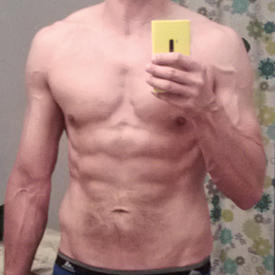Question about Squats
Replies
-
Feet pointing at 30 degrees and knees tracking in line with them allows for deeper squatting. Who knows though, maybe your trainer knows better than world champ power lifters.0
-
Feet pointing at 30 degrees and knees tracking in line with them allows for deeper squatting. Who knows though, maybe your trainer knows better than world champ power lifters.
The best stance varies from person to person depending on how much flexibility and mobility they have. Those that are tight need the wider stance and/or toe angle.
The ideal squatting stance is feet shoulder width apart, toes straight ahead, but few are flexibile and mobile enough to use that stance.
For more info check out the mobility guru kstarr at mobilityWOD.0 -
Feet pointing at 30 degrees and knees tracking in line with them allows for deeper squatting. Who knows though, maybe your trainer knows better than world champ power lifters.
Eh, 3 certifications and been in the business 5 years.. plus goes to conventions with world champ powerlifters, yea I'd say he'd knows what he's talking about.
Plus, not everyone who squats is looking to squat 500+ pounds like a power lifter.. have to take that into consideration too.0 -
I would like to add to clarify, I never said and do not advocate squatting with your toes pointing out at an unnatural angle. The toes and knees should be pointing in the same direction, when viewed from above, the knee should track forwards and backwards in a straight line along where the toes are pointing. Ideally with the knee not extending past the toes.
I agree with this.
I asked my trainer about that whole toes pointing out 30 degrees thing, and he looked at me like I was nuts.
Told me to keep my feet pointing straight but put pressure on the outside of foot so my knees go out instead of in...and thus not ruin my knees!
Ahhh! To clarify further, I never said where the toes should be pointing, I meant that the knees should track in the same direction as the toes of the leg they're both attached to.
Basically pointing out a little is normal, but would everybody please stop doing plie squats.0 -
Feet pointing at 30 degrees and knees tracking in line with them allows for deeper squatting. Who knows though, maybe your trainer knows better than world champ power lifters.
Eh, 3 certifications and been in the business 5 years.. plus goes to conventions with world champ powerlifters, yea I'd say he'd knows what he's talking about.
Plus, not everyone who squats is looking to squat 500+ pounds like a power lifter.. have to take that into consideration too.
The weight is not as significant as depth although if the weight is low enough to not actually build quad strength then it would not matter as much. If the depth is too shallow with weight high enough, you will get too much strength imbalance between quads and hams which is the real way to cause knee problems with squatting. Certifications don't mean much in any business. Take it from someone who has talked to literally thousands of Microsoft Certified IT people who don't know jack. And going to conventions doesn't mean they spent time discussing the finer details of squatting.0 -
-
Nice.
Cliffs: Turn your toes out.0 -
You can train muscles to be more contracted at rest. This is toning.
THIS^^^^^^^^^^^^
OP, Squats will help your thighs. The person who told you that it helps your quads must not realize that your quadriceps are part of your thighs. Squats are good for thighs, back, and belly. They are one of the best exercises that you can do for body weight exercises. In fact, if you do squats and push-ups only, you have done an excellent workout.0 -
Check this http://www.leangains.com/2011/09/*uckarounditis.html Change the * to an F
So you're saying doing balance exercises is f*cking around? Any medical evidence, from research journals, that it doesn't work?
Personally, as someone on the autism spectrum who is hypermobile and has difficulty with balance, coordination, and weak muscle tone, I've found squatting on an upside down Bosu ball to be the most effective exercise for me, so far. It has improved the muscles in my thighs, as well as helping me with balance and core stability. Hence I assumed it was working more muscles than regular bodyweight squats, which haven't had those effects.
But if you have some evidence-based exercise that works better for my particular issues, then I would be genuinely interested to hear it. There don't tend to be many experts in how to work on the particular issues that people on the autism spectrum have, so a lot of us just have to work it out by trial and error.
From what I understand, squating on an upsided down bosu ball is more for working stabilizing muscles and core (quads more secondary). I squat over 100 lbs, but on the upside down bosu ball, I am just holding a 10 lb weight and trying not to fall on my *kitten*.0 -
From what I understand, squating on an upsided down bosu ball is more for working stabilizing muscles and core (quads more secondary). I squat over 100 lbs, but on the upside down bosu ball, I am just holding a 10 lb weight and trying not to fall on my *kitten*.
Ah, okay. Thanks for explaining. That is what I was imagining - that it is working muscles for core stability, which regular squats don't do so much. And it is what I am aiming for - core stability for balance. It does seem to be working my quads too - they have become a lot more defined since doing this exercise regularly. Squatting with weights is not something I can do yet, but I'm happy to start slow and work my way up - not really looking to build huge muscles anyway. More wanting functional strength and stability for everyday life and work.0 -
Thank you so much! Guess I shall slow down... A LOT and try adding some weights to my squats. I never thought of spreading my legs farther apart. I guess I was under the impression that they should always be shoulder width apart. I shall try that as well. Thank you everyone for your input! It is very much appreciated!
HEELS about shoulder width or slightly wider, feet turned out 30ish degrees, shins\knees stay in line with feet.
Correct. Who would squat with toes pointed forward? I wouldn't trust anything from someone who gives advice like that.0
This discussion has been closed.
Categories
- All Categories
- 1.4M Health, Wellness and Goals
- 398.1K Introduce Yourself
- 44.7K Getting Started
- 261K Health and Weight Loss
- 176.4K Food and Nutrition
- 47.7K Recipes
- 233K Fitness and Exercise
- 462 Sleep, Mindfulness and Overall Wellness
- 6.5K Goal: Maintaining Weight
- 8.7K Goal: Gaining Weight and Body Building
- 153.5K Motivation and Support
- 8.4K Challenges
- 1.4K Debate Club
- 96.5K Chit-Chat
- 2.6K Fun and Games
- 4.8K MyFitnessPal Information
- 12 News and Announcements
- 21 MyFitnessPal Academy
- 1.5K Feature Suggestions and Ideas
- 3.2K MyFitnessPal Tech Support Questions






